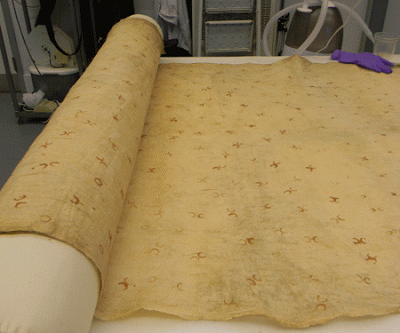This post has been written by Kloe Rumsey, a conservation intern from the Conservation Practice MSc course at Cardiff University.
This large barkcloth, 1886.1.1236 is one of about twenty three pieces in the Pitt
Rivers Cook-Voyage collections and is one of three with similar
surface designs.
 |
| 1886.1.1236 Detail |
As suggested on the Ashmolean label applied by Assistant Curator Edward
Evans in 1886, just before transfer to the newly-opened Pitt Rivers Museum, it is now known
to originate from Tahiti and collected on Cook's second voyage in 1773-4.
Also bought back to England from this voyage was O'Mai, a man from Raiatea, who, during his 2 year visit to Europe, became famous in high society as
the 'noble savage'.
In this illustration of O'Mai by Nathaniel Dance his
barkcloth clothing is of the type worn by those of high rank and it can be
seen to include a patterned piece of the same distinctive circular
design. The similarities between the garments in this drawing, and
objects held in the Forster collections of the Pitt Rivers are striking,
and has been noted by then curator Peter Gathercole in the short catalogue to the 1970 Pitt Rivers' exhibition 'From the Islands of the South Seas 1773-4'
The design of this cloth (described in the Catalogue of Curiosities as 'No.15 a yellow piece with red spots') was created by dipping
the cut end of bamboo into the dye and applying it to the cloth. Though
simple, there is great variation in the patterns and characters created
and it is thought that this was the primary method for printed
decoration of barkcloths in Tahiti at the time of Cooks' visit.
There seems to have been a dramatic change in the decorative style of barkcloth in Tahiti
following European contact. This cloth a particularly noteworthy
example of a very early style, soon replaced by fern printed
patterns and other shapes created by the application of painted leaves
onto barkcloth.
Other illustrations of Tahitian barkcloth as garments, as
well as the specific description of 'yellow' in the catalogue of
curiosities suggests that this, now cream coloured piece has faded from a
brighter yellow colour.
Despite the very 'bloody' appearance of this red dye there
is no reference to blood being used as a printing medium and it is
likely that it is one of the many colours derived from fruits, leaves
and bark.
As it can be seen in images from earlier posts these
cloths have been stored folded, and, as part of the conservation
treatment of this piece it has been surface-cleaned with a conservation-grade soft sponge and
humidified to remove damaging creases.
 |
| Creases being flattened with the aid of an ultrasonic humidifier |
The barkcloth was torn in a few areas, and the tears were repaired with Japanese tissue
and arrowroot starch paste.
 |
| Using Japanese tissue and starch paste to repair a tear |
This treatment means this cloth can now be more easily rolled around a support and stored safely.
 |
| Barcloth being rolled around a calico covered support |
